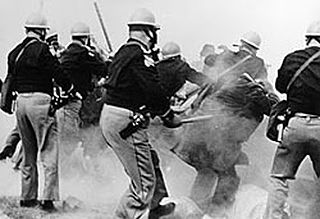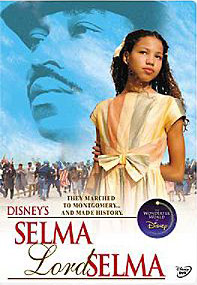Related Research Articles

Selma is a city in and the county seat of Dallas County, in the Black Belt region of south central Alabama and extending to the west. Located on the banks of the Alabama River, the city has a population of 17,971 as of the 2020 census. About 80% of the population is African-American.

The Selma to Montgomery marches were three protest marches, held in 1965, along the 54-mile (87 km) highway from Selma, Alabama, to the state capital of Montgomery. The marches were organized by nonviolent activists to demonstrate the desire of African-American citizens to exercise their constitutional right to vote, in defiance of segregationist repression; they were part of a broader voting rights movement underway in Selma and throughout the American South. By highlighting racial injustice, they contributed to passage that year of the Voting Rights Act, a landmark federal achievement of the civil rights movement.

Amelia Isadora Platts Boynton Robinson was an American activist who was a leader of the American Civil Rights Movement in Selma, Alabama, and a key figure in the 1965 Selma to Montgomery marches. In 1984, she became founding vice-president of the Schiller Institute affiliated with Lyndon LaRouche. She was awarded the Martin Luther King Jr. Freedom Medal in 1990. Robinson was a centenarian reaching the age of 104.

The Mississippi State Sovereignty Commission was a state agency in Mississippi from 1956 to 1977 tasked with fighting desegregation and controlling civil rights activism. It was overseen by the Governor of Mississippi. The stated objective of the commission was to "[...] protect the sovereignty of the state of Mississippi, and her sister states" from "encroachment thereon by the Federal Government". It coordinated activities to portray the state and racial segregation in a more positive light. Serving governors and lieutenant governors of Mississippi were ex officio members of the commission. The Sovereignty Commission spied on and conspired against civil rights activists and organized pressure and economic oppression of those who supported the civil rights movement in Mississippi.

Viola Fauver Liuzzo was an American civil rights activist. In March 1965, Liuzzo heeded the call of Martin Luther King Jr. and traveled from Detroit, Michigan, to Selma, Alabama, in the wake of the Bloody Sunday attempt at marching across the Edmund Pettus Bridge. Liuzzo participated in the successful Selma to Montgomery marches and helped with coordination and logistics. At the age of 39, while driving back from a trip shuttling fellow activists to the Montgomery airport, she was fatally hit by shots fired from a pursuing car containing Ku Klux Klan members Collie Wilkins, William Eaton, Eugene Thomas, and Gary Thomas Rowe, the last of whom was actually an undercover informant working for the Federal Bureau of Investigation (FBI). Although the State of Alabama was unable to secure a murder conviction, Wilkins, Eaton, and Thomas were charged in federal court with conspiracy to intimidate African Americans under the 1871 Ku Klux Klan Act, a Reconstruction civil rights statute. On December 3, the trio was found guilty by an all-white, all-male jury, and were sentenced to ten years in prison, a landmark in Southern legal history.

James Joseph Reeb was an American Unitarian Universalist minister, pastor, and activist during the civil rights movement in Washington, D.C. and Boston, Massachusetts. While participating in the Selma to Montgomery marches actions in Selma, Alabama, in 1965, he was murdered by white segregationists, dying of head injuries in the hospital two days after being severely beaten. Three men were tried for Reeb's murder but were acquitted by an all-white jury. His murder remains officially unsolved.

Frank Minis Johnson Jr. was a United States district judge and United States Circuit Judge serving 1955 to 1999 on the United States District Court for the Middle District of Alabama, United States Court of Appeals for the Fifth Circuit and United States Court of Appeals for the Eleventh Circuit. He made landmark civil rights rulings that helped end segregation and disenfranchisement of African Americans in the South. In the words of journalist and historian Bill Moyers, Judge Johnson "altered forever the face of the South."

James "Spider" Martin was an American photographer known for his work documenting the American Civil Rights Movement in 1965, specifically Bloody Sunday and other incidents from the Selma to Montgomery marches.

Selma, Lord, Selma is a 1999 American made-for-television biographical drama film based on true events that happened in March 1965, known as Bloody Sunday in Selma, Alabama. The film tells the story through the eyes of an 9-year-old African-American girl named Sheyann Webb. It was directed by Charles Burnett, one of the pioneers of African-American independent cinema. It premiered on ABC on January 17, 1999.

The Edmund Pettus Bridge carries U.S. Route 80 Business across the Alabama River in Selma, Alabama. Built in 1940, it is named after Edmund Pettus, a former Confederate brigadier general, U.S. senator, and state-level leader of the Alabama Ku Klux Klan. The bridge is a steel through arch bridge with a central span of 250 feet (76 m). Nine large concrete arches support the bridge and roadway on the east side.
Albert J. Lingo was appointed in 1963 by Alabama Gov. George Wallace to head the Alabama Highway Patrol, which he led until 1965 during turbulent years marked by marches and demonstrations that characterized the Civil Rights Movement in the U.S. South.
The history of the 1954 to 1968 American civil rights movement has been depicted and documented in film, song, theater, television, and the visual arts. These presentations add to and maintain cultural awareness and understanding of the goals, tactics, and accomplishments of the people who organized and participated in this nonviolent movement.

Frederick Douglas Reese was an American civil rights activist, educator and minister from Selma, Alabama. Known as a member of Selma's "Courageous Eight", Reese was the president of the Dallas County Voters League (DCVL) when it invited the Southern Christian Leadership Conference and Martin Luther King Jr. to Selma to amplify the city's local voting rights campaign. This campaign eventually gave birth to the Selma to Montgomery marches, which later led to the passage of the Voting Rights Act.
This is a timeline of the civil rights movement in the United States, a nonviolent mid-20th century freedom movement to gain legal equality and the enforcement of constitutional rights for people of color. The goals of the movement included securing equal protection under the law, ending legally institutionalized racial discrimination, and gaining equal access to public facilities, education reform, fair housing, and the ability to vote.
The Dallas County Voters League (DCVL) was a local organization in Dallas County, Alabama, which contains the city of Selma, that sought to register black voters during the late 1950s and early 1960s.

The 1968 United States presidential election in Mississippi was held on November 5, 1968. Mississippi voters chose seven electors, or representatives to the Electoral College, who voted for President and Vice-President.
The Message from Mississippi is a state-sponsored 1960 segregationist propaganda film produced by the Mississippi Sovereignty Commission, a state government agency established to promote and defend segregation in the wake of the Brown v. Board of Education U.S. Supreme Court decision desegregating public schools. In the film, Mississippi governor Ross Barnett says that Blacks in Mississippi preferred the state's segregated way of life.
Oxford, U.S.A. is a 16 mm documentary film about the integration of the University of Mississippi in 1962. It promotes the segregationist cause by arguing that the federal government violated the U.S. Constitution it prohibitted segregation in public schools. Three prints of the film were purchased by the Mississippi Sovereignty Commission, a state agency established to defend and promote Mississippi's segregation practices against federal intervention in the wake of the U.S. Supreme Court's Brown v. Board of Education decision. A leader of the commission was scheduled to speak after a showing of the film. The commission also funded the 1960 film The Message from Mississippi promoting the segregationist "way of life".
The Louisiana State Sovereignty Commission was a government agency of the Louisiana state government established to combat desegregation, which operated from June 1960 to 1967 in the capitol city of Baton Rouge, Louisiana. The group warned of "creeping federalism", and opposed school racial integration. It allied with the Louisiana Joint Legislative Committee on Un-American Activities, and coordinated with the Mississippi State Sovereignty Commission.
Keitz and Herndon was an American television production company that made cartoons, advertisements, short educational films, and commercials founded in 1952 in Oak Cliff neighborhood in Dallas, Texas. Most notably they created the "Frito Kid" mascot for Fritos; and the animated television series, JOT.
References
- 1 2 ""Sovereignty Commission Bulletin," publication of the Alabama State Sovereignty Commission. Sovereignty Commission Bulletin, Volume 1, Number 1". Alabama Department of Archives and History.
- ↑ "Alabama Compiling Files On Civil Rights Advocates". The New York Times. February 17, 1964.
- ↑ Katagiri, Yasuhiro (September 18, 2009). The Mississippi State Sovereignty Commission: Civil Rights and States' Rights. University Press of Mississippi. ISBN 9781496801258 – via Google Books.
- ↑ Gray, Jeremy (October 5, 2013). "Alabama Sovereignty Commission formed with sweeping powers, no public oversight (Oct. 5, 1963)". al.com.
- 1 2 3 4 5 Lyman, Brian (February 2019). "'State of Alabama:' The racist anti-Selma film, and the secret state commission that funded it". Montgomery Advertiser.
- ↑ Gray, Jeremy (December 21, 2013). "7 people named to Alabama Sovereignty Commission (Dec. 21, 1963)". al.com.
- ↑ "Edmund R. Blair, Editor And Publisher, Passes" (PDF). PellCityLibrary.com. St. Clair News-Aegis. April 13, 1972.
- ↑ "Selma to Montgomery Rights March photographs, 1965". WorldCat.
- 1 2 "Invoice from Keitz & Herndon, Inc., for work done on a film about the Selma-to-Montgomery march, which was produced by the Alabama Sovereignty Commission". Alabama Department of Archives and History.
- ↑ Mitchell, Jerry. "History: Ben Brown, 2 students killed at JSU". The Clarion-Ledger.
- ↑ State Voting Handbook. Alabama State Sovereignty Commission, State of Alabama. 1970.
- ↑ "Alabama State Sovereignty Commission, 1963-1978". University of South Alabama Libraries.
- ↑ Katagiri, Yasuhiro (January 6, 2014). Black Freedom, White Resistance, and Red Menace: Civil Rights and Anticommunism in the Jim Crow South. LSU Press. ISBN 9780807153147 – via Google Books.